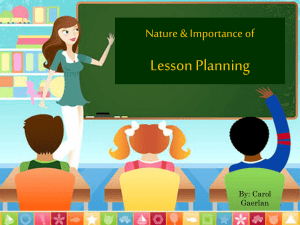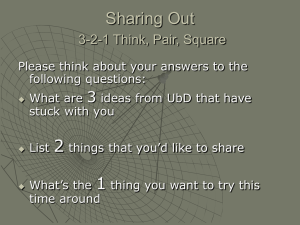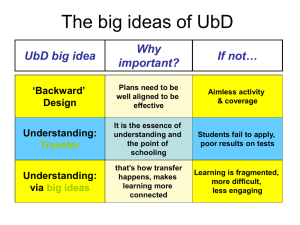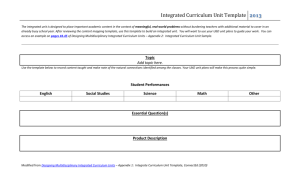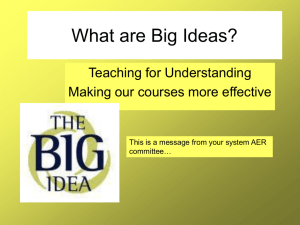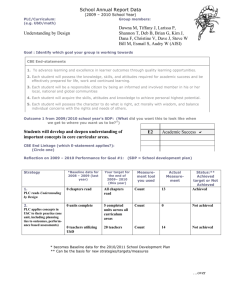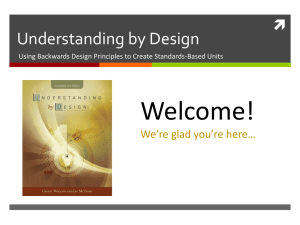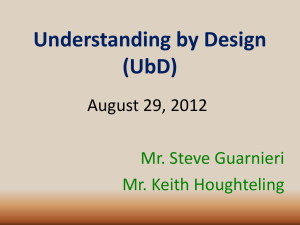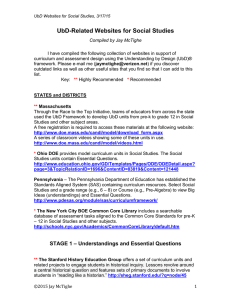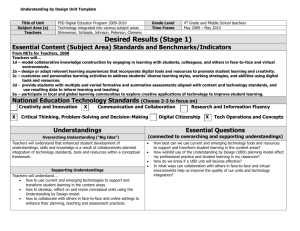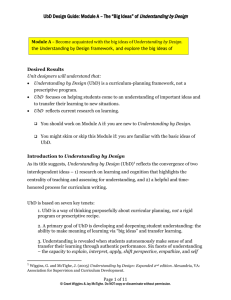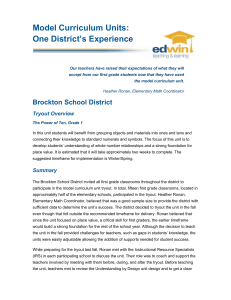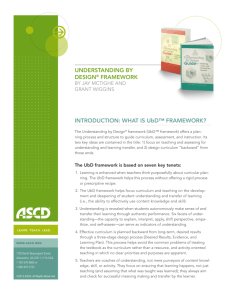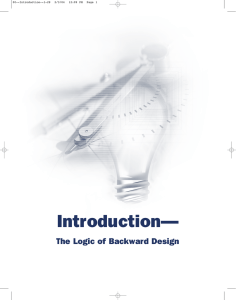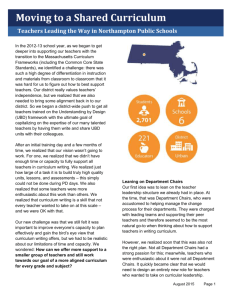UbD Template for Understanding Understanding by Design
advertisement
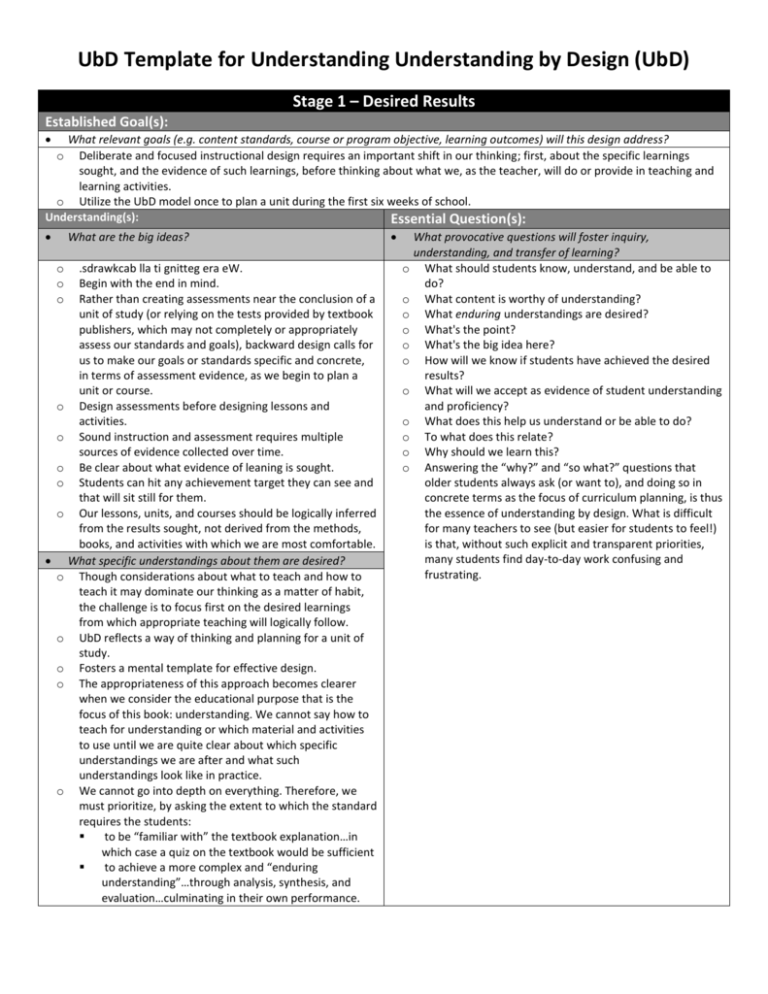
UbD Template for Understanding Understanding by Design (UbD) Stage 1 – Desired Results Established Goal(s): What relevant goals (e.g. content standards, course or program objective, learning outcomes) will this design address? Deliberate and focused instructional design requires an important shift in our thinking; first, about the specific learnings sought, and the evidence of such learnings, before thinking about what we, as the teacher, will do or provide in teaching and learning activities. o Utilize the UbD model once to plan a unit during the first six weeks of school. Understanding(s): Essential Question(s): o What are the big ideas? o o o o o o o o o o o o o .sdrawkcab lla ti gnitteg era eW. Begin with the end in mind. Rather than creating assessments near the conclusion of a unit of study (or relying on the tests provided by textbook publishers, which may not completely or appropriately assess our standards and goals), backward design calls for us to make our goals or standards specific and concrete, in terms of assessment evidence, as we begin to plan a unit or course. Design assessments before designing lessons and activities. Sound instruction and assessment requires multiple sources of evidence collected over time. Be clear about what evidence of leaning is sought. Students can hit any achievement target they can see and that will sit still for them. Our lessons, units, and courses should be logically inferred from the results sought, not derived from the methods, books, and activities with which we are most comfortable. What specific understandings about them are desired? Though considerations about what to teach and how to teach it may dominate our thinking as a matter of habit, the challenge is to focus first on the desired learnings from which appropriate teaching will logically follow. UbD reflects a way of thinking and planning for a unit of study. Fosters a mental template for effective design. The appropriateness of this approach becomes clearer when we consider the educational purpose that is the focus of this book: understanding. We cannot say how to teach for understanding or which material and activities to use until we are quite clear about which specific understandings we are after and what such understandings look like in practice. We cannot go into depth on everything. Therefore, we must prioritize, by asking the extent to which the standard requires the students: to be “familiar with” the textbook explanation…in which case a quiz on the textbook would be sufficient to achieve a more complex and “enduring understanding”…through analysis, synthesis, and evaluation…culminating in their own performance. o o o o o o o o o o o What provocative questions will foster inquiry, understanding, and transfer of learning? What should students know, understand, and be able to do? What content is worthy of understanding? What enduring understandings are desired? What's the point? What's the big idea here? How will we know if students have achieved the desired results? What will we accept as evidence of student understanding and proficiency? What does this help us understand or be able to do? To what does this relate? Why should we learn this? Answering the “why?” and “so what?” questions that older students always ask (or want to), and doing so in concrete terms as the focus of curriculum planning, is thus the essence of understanding by design. What is difficult for many teachers to see (but easier for students to feel!) is that, without such explicit and transparent priorities, many students find day-to-day work confusing and frustrating. What misunderstandings are predictable? But many teachers begin with and remain focused on textbooks, favored lessons, and time-honored activities— the inputs—rather than deriving those means from what is implied in the desired results—the output. To put it in an odd way, too many teachers focus on the teaching and not the learning. They spend most of their time thinking, first, about what they will do, what materials they will use, and what they will ask students to do rather than first considering what the learner will need in order to accomplish the learning goals. o A form of aimlessness goes by the name of “coverage,” an approach in which students march through a textbook, page by page (or teachers through lecture notes) in a valiant attempt to traverse all the factual material within a prescribed time. o This is all quite logical when you come to understand it, but “backward” from the perspective of much habit and tradition in our field. A major change from common practice occurs as designers must begin to think about assessment before deciding what and how they will teach. o Teachers are often satisfied by signs of apparent understanding, such as when students deliver the right words, definitions, or formulas. o Students will know: Students will be able to: What key knowledge and skills will students acquire as a result of this unit? Understand the basics of the UbD planning process and the planning template. What should they eventually be able to do as a result of such knowledge and skill? o Utilize the UbD planning process and planning template. o Stage 2 – Assessment Evidence Performance Task(s): Other Evidence: Through what authentic performance tasks will students demonstrate the desired understandings? o Utilizing the UbD template By what criteria will performances of understanding be judged? o Through what other evidence (e.g. quizzes, tests, academic prompts, observations, homework, journals) will students demonstrate achievement of the desired results? o Engaging group activities How will students reflect upon or self-assess their learning? o Discussion with peer groups Stage 3 – Learning Plan Learning Activities: W: Help the students know WHERE the unit is going and what is expected…Help the teacher know WHERE the students are coming from (prior knowledge, interests) o PowerPoint presentation, UbD planning template H: HOOK all students and hold their interest o PowerPoint presentation, engaging group activities, video, audio, stories, E: EQUIP students, help them experience the key ideas, and explore the issues o Provide UbD planning template, model template, use individualized favored lesson, R: Provide opportunities to RETHINK and REVISE their understandings and work o Provide technical assistance when requested via phone or by email E: Allow students to EVALUATE their work and its implications o Review work against team members, against the handout T: Be TAILORED (personalized) to the different needs, interests, abilities of learners o Enable users to develop a plan for a favored lesson O: Be ORGANIZED to maximize initial and sustained engagement as well as effective learning o Professional Learning Communities (PLCs) That Work 4 Essential Questions What do we want students to know? o How will we know when they know it? o What will we do when they don’t learn it? o What will we do when they do learn it? o
